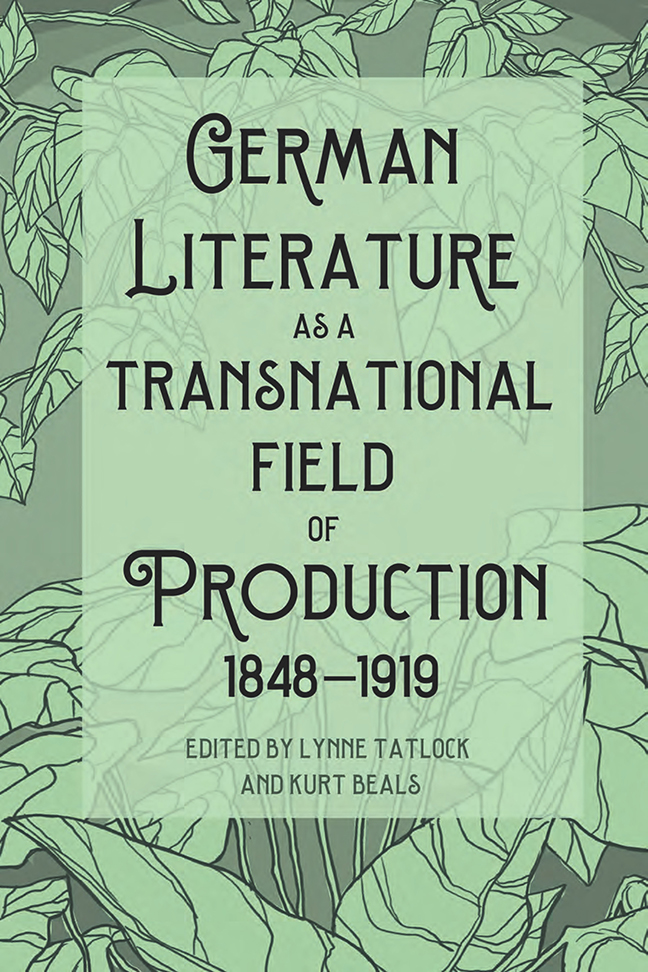Book contents
- Frontmatter
- Contents
- Acknowledgments
- Introduction: A Transnational Literary Field in the Age of Nationalism
- 1 The Passion of Johannes Scherr: Historiography as Trauma
- 2 Between Integration and Differentiation: On the Relationship between German and Austrian Literature in the Second Half of the Nineteenth Century
- 3 Reading Stifter in America
- 4 Travel Writing and Transnational Marketing: How Ida Pfeiffer brought the World to Austria and Beyond
- 5 Ernst Brausewetter's Meisternovellen Deutscher Frauen (1897–98): Gender, Genre, and (Inter)National Aspiration
- 6 Arbiter of Nation? The Strange Case of Hans Müller-Casenov's The Humour of Germany (1892/1893)
- 7 Visualizing the End: Nation, Empire, and Neo-Roman Mimesis in Keller and Fontane
- 8 Eurocentric Cosmopolitanism in Thomas Mann's Buddenbrooks
- 9 European Peace from a Transatlantic Perspective: Victor Hugo and Bertha von Suttner
- 10 Hermann Graf Keyserling and Gu Hongming’s Ethics of World Culture: Confucianism, Monarchism, and Anti-Colonialism
- 11 Constructing Symphonic Worlds: Gustav Mahler, Weltliteratur, and the Musical Program
- 12 The Garb of National Literature: Transnational Identities and the Early Twentieth-Century Schriftstreit
- 13 From European Symbolism to German Gesture: The International and Transnational Nationalism of Stefan George's Blätter für die Kunst
- 14 Canon Fire: Dada's Attack on National Literature
- Selected Bibliography
- Contributors
- Index
9 - European Peace from a Transatlantic Perspective: Victor Hugo and Bertha von Suttner
Published online by Cambridge University Press: 10 January 2024
- Frontmatter
- Contents
- Acknowledgments
- Introduction: A Transnational Literary Field in the Age of Nationalism
- 1 The Passion of Johannes Scherr: Historiography as Trauma
- 2 Between Integration and Differentiation: On the Relationship between German and Austrian Literature in the Second Half of the Nineteenth Century
- 3 Reading Stifter in America
- 4 Travel Writing and Transnational Marketing: How Ida Pfeiffer brought the World to Austria and Beyond
- 5 Ernst Brausewetter's Meisternovellen Deutscher Frauen (1897–98): Gender, Genre, and (Inter)National Aspiration
- 6 Arbiter of Nation? The Strange Case of Hans Müller-Casenov's The Humour of Germany (1892/1893)
- 7 Visualizing the End: Nation, Empire, and Neo-Roman Mimesis in Keller and Fontane
- 8 Eurocentric Cosmopolitanism in Thomas Mann's Buddenbrooks
- 9 European Peace from a Transatlantic Perspective: Victor Hugo and Bertha von Suttner
- 10 Hermann Graf Keyserling and Gu Hongming’s Ethics of World Culture: Confucianism, Monarchism, and Anti-Colonialism
- 11 Constructing Symphonic Worlds: Gustav Mahler, Weltliteratur, and the Musical Program
- 12 The Garb of National Literature: Transnational Identities and the Early Twentieth-Century Schriftstreit
- 13 From European Symbolism to German Gesture: The International and Transnational Nationalism of Stefan George's Blätter für die Kunst
- 14 Canon Fire: Dada's Attack on National Literature
- Selected Bibliography
- Contributors
- Index
Summary
The final act of the Congress of Vienna in 1815 was to document the failure of French-Napoleonic supremacy in continental Europe as well as new cooperation between the old and the restored monarchies. In their foreign relations, the powers assured mutual military aid in the case of domestic revolutions. This alliance was declared to be “holy.” However, after the suppression of civil wars and secessionist uprisings between 1815 and 1851—the revolutions in 1830 and 1848 come to mind—the monarchs believed that they had strengthened their positions domestically, and the second half of the nineteenth century consequently saw a new trend of an unrestrained willingness to start wars against former allies. The monarchs wasted no more thought on permanent supranational associations that could have influenced them in the decision-making process about military campaigns. A similar attitude had been typical for rulers in the pre-revolutionary eighteenth century, when the trauma from the destruction of the Thirty Years’ War no longer held sway and when the storming of the Bastille in Paris on July 14, 1789, was not yet in sight. The Peace of Westphalia in the middle of the seventeenth century granted sovereignty to the European nation-states and so there was no supranational authority under international law that could have put a stop to the warfare. Monarchs in the second half of the nineteenth century also returned to the old foreign policy principle of a continental equilibrium of powers. Wars were started again in the name of European equilibrium, but the peace expected to result from these wars always remained a phantom.
After 1851, the sovereign nation-state became the dominant model for the great powers in Europe. The American Revolution of 1776 and the French Revolution of 1789 had shown the extreme opposition between the republican national and the dynastic state model, but after the suppression of social and regional/national uprisings, the European monarchies were able to accept a form of a nation-state that would keep the monarchs in power while still allowing concessions to be made to the expectations of the rising middle classes. The French state under both the “citizen king,” Louis-Philippe, and Napoleon III was a typical example of this fusion, which represented neither the Old Regime nor the New Republicanism. When Napoleon III lost the war against Germany, the French nation-state again became a republic.
- Type
- Chapter
- Information
- Publisher: Boydell & BrewerPrint publication year: 2023



